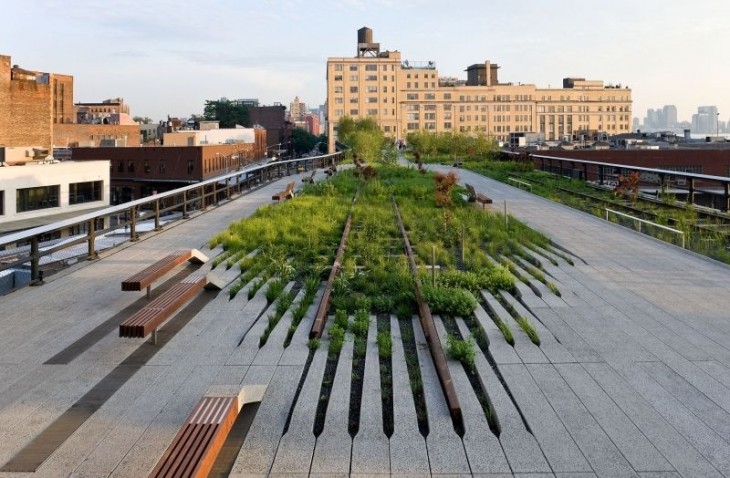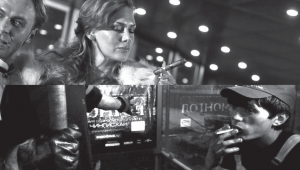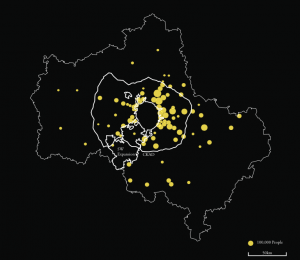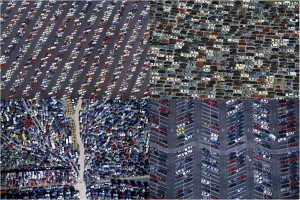Towards the end of the Ottoman Empire, Istanbul was like a colonial capital. City services were owned by foreign private companies. Factories for production was also belong to foreign capital. With the local train network, the city was expanding towards its periphery. In 1923, the Ottoman Empire period ended in 1923 with the foundation of Turkish Republic and this led all foreign capital to leave the country.
There was a global economic crisis in 1929 as a consequence Wall Street Crash. It affected newly founded Turkish Republic as it did rest of the world. Private companies and capitals were weak in power. The industrial development was held by the state. State owned factories were built in throughout Turkey and railroad network to connect them were expanded. Despite the limited resources of the period, the transportation network of Istanbul was growing also, until they asked a French urban planner called Henry Prost to make a new urban plan for Istanbul. Henry Prost planned to turn pedestrian oriented city into a more car oriented one. The States which just got out from the WW2 was also supporting this urban plan with financial aid. Eventually all of the tram network were replaced by motorways. During this transformation many of the historic buildings-some of them even dating back from Byzantine times-were wiped off from the world. Industrialisation had a huge impact on working class. The mechanisation of agriculture throughout the country left the farmers without work. In the meantime, Istanbul was packed with private factories. People who used to be farmers couldn’t function in this set up. So they became the cheep labor for these factories. There was a silent agreement between social classes. Neither the state nor the bosses of factories provided housing for the labourers. Instead of this, they were letting the workers to invade empty lots and build their home there illegally. In 1973 the first bridge on the Bosphorus which connects the Asian and European side was opened. This led illegal settlements to flourish more than ever. Motorway traffic went up 6 times in 15 years.
In the 70s, Turkish government adapted Latin American Economic Model, in other words a model called Neoliberalism. Public services were privatised, all of the savings and gains were sold to private investors. Municipality budgets were increased drastically. The state authorised a special law for the owners of the illegal houses. If the shanties were converted into apartments, the state would accept them as legal. This law shift the existing classes. Lower class labourers became the middle class, who own the apartments for the newly coming immigrants from the eastern Turkey. In 1988 second bridge on Bosphorus was opened. This reinforced even more the motorisation of the city. This time not only illegal houses were emerging but also gated communities and shopping malls for the rich were invading the last forest areas of the city.
1990s for Istanbul was about competing “global cities”. Neoliberalism model widened the income gap between the rich and the poor. The industry moved to the outskirts of the city to explore cheap labor there. Thus, turning the city into a consumer heaven, inhabited by only service sector workers. In the beginning of 2000s Istanbul was officially being marketed to foreign and local investors. The state’s housing administration and the municipalities were provided with special laws which enabled them to sell the abandoned industrial areas, public schools, hospitals and lower class labourer neighbourhoods to domestic and foreign capital owners. The workers were pushed out to isolated islands of poverty in the periphery of the city and they became the service workers of the new “global city”.
With the 3rd bridge on the Bosphorus which is currently under construction and other future bridges, Istanbul will turn into an ever expanding city without any limits, lacking of water reservoirs, forests or any public common spaces.
Istanbul’s story is not a unique one. In China Hangzhou, Portugal-Lisbon citizens had to suffer from the same causes. They’re all fast growing cities which want to be a “global city”. Large amount of shopping malls, international banks, large investments, concentrated wealth are all futures which are common for these cities. However these so called “developments” are happening all for a cost. New forces of investments are pushing away the very own people who built the city centre, from the city centre to periphery. People are expulsed with force from towns they lived for hundreds of years. Can you plan a “global city” ? Can a “global city” be planned separate from all of the country ? There you find the starting point of all the problems. Only Istanbul is invested, only Istanbul is developed.
Ayazma is a small neighbourhood in Istanbul, mostly a shantytown. Even though it is small, it is a living example of global neoliberal policies. With Ayazma example, we see how cities become a place for economic speculations, how land become something with material value. This area without any infrastructure and state services at the periphery of the city, turned valuable after the olympic stadium was built. Before it was too far from site, neglected. Suddenly it became valuable and the inhabitants are forced to migrate. The area is planned to be turned into luxurious gated community housing area. The whole transformation of the area is based on architectural drawings that claim to make things “better”. However it is not enough. All human beings have right to shelter, although it is not clear in our constitution. So as a result, politicians and capital owners can manipulate this gap in the system however they want, avoiding people’s right to access healthy environment, education, transportation and privacy. Many of the children of the victims of urban renewal projects can no longer attend to school because of the demolitions. They don’t have anywhere to call home or any money, so children work to bring more money to their family. The problem is basic. It lies on the simple economic actions of the state. All of the production, industry is concentrated in metropolitan city of Istanbul. The factories and the large farms opened in the first decades of republic throughout the country are now abandoned. There are so many fertile lands to grow sugar, tobacco, sunflower etc which now stay idle. If there were jobs in Anatolia, if there were factories there, why would people leave their hometown behind and come to Istanbul with maximum wage of 200 Euros ?
Global actors look for a place to invest, they look for a land; because they can do things easier in Turkey than they do in their countries because of their democratic processes. This enables them to make mega investments, drastic construction executions. Can you build a hotel in Central Park ? They did in Istanbul. A city needs to breath. A city needs rain water to meet with soil. We think in Turkey, building underground parking under green parks is a sign of high civilisation level. We think bulldozing natural greenery and erecting huge concrete blocks instead and putting plants on their balconies is a sign of advancement. We build houses in natural forest areas and making artificial lakes from the underground water. We live in concrete Faraday cages. Sooner to later this city will eat up its inhabitants.
I would like to talk about more on the social housing model which our state adopted. Since the WW2, the model of capitalistic accumulation was based on mass production and mass consumption. This growth engine functioned for several decades and lead to European welfare states. In order to limit the costs of labor force and to provide housing for them, “mass housing construction” was invented. This mass housing was only composed of residential areas. They were all isolated and separate from other aspects of life such as leisure, consumption etc. This model was criticised in Europe in 70s. Because it led to inhumane dwelling conditions without any social interaction space provided. That’s why we cannot solve the shantytown issues like the one in Ayazma-Istanbul, by rapidly constructed, poor quality buildings. Because shantytowns are not an urban issue but rather a social problem. However this is what is proposed or more likely imposed on eviction victims. They are expulsed because of the urban renewal projects and forced to live in basic tenement buildings which are concentrated concrete blocks, far from their jobs (which they earn money just enough to live day by day), isolated and without any social interaction space. We know from the history of the cities, this model failed a long time ago. Today these kinds of social housings are bombed down. Undoubtedly within 20 years these social housings built in Istanbul will generate serious problems and they are going to be bombed down as well for a high economic and social price. This model divides Istanbul based on economical classes. They take the poor from the city centre under the act of “urban renewal projects”, rich people settle to city centre and the poor is forced to live in the outskirts of the city, far from site. So the policies divides the rich and the poor further apart not only socially but also physically. Now it is almost impossible in Istanbul to see different economic/social classes to interact in public sphere. The state’s acts divided people as “us” and “them”. People now are afraid of their maids. This is risky in terms of peace in the city and coexistence of different cultures and classes. City is also for the poor. City must provide habitation for all.
Now what is left ? The ecological, population and economic levels have been surpassed. Where will this lead us ? Obviously to chaos… This system clearly is not working. The cost for the humanity is too much. The rich’s income level is getting higher with this system and this is good. But more important is the distribution of that income level. Because in fact level of advancement is measured by the latter concept. However it seems that the state won’t change this model in near future. So the citizens have to protect their own living spaces. We create our own cities. But in turn these spaces we create also create us. So we have to build cities what we aspire to be as humans.





